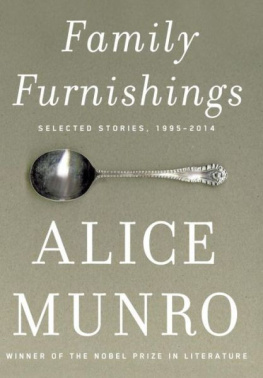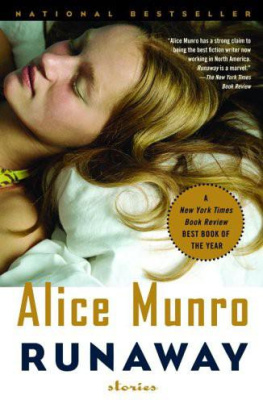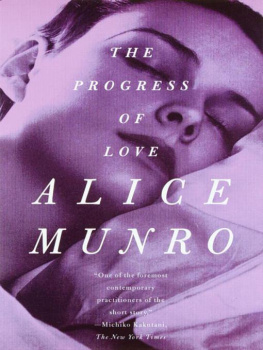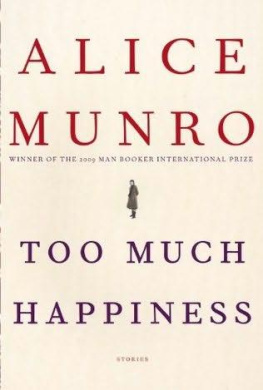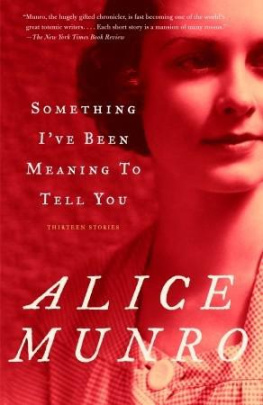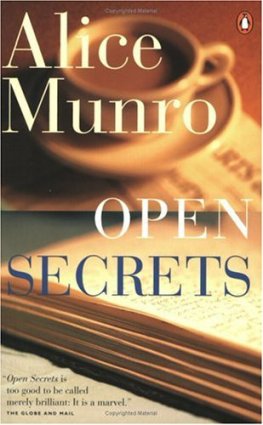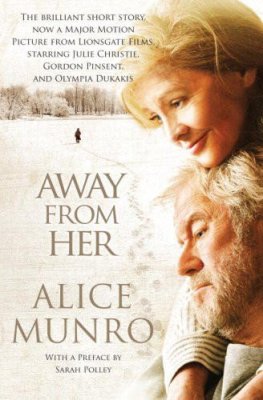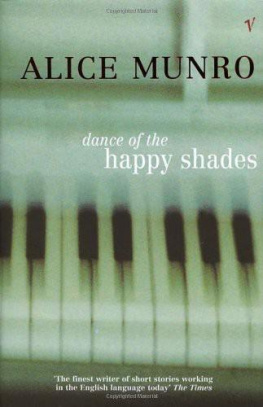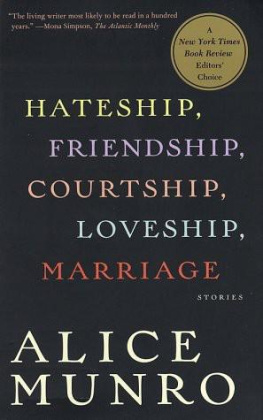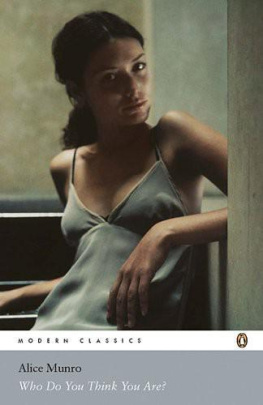Alice Munro - Family Furnishings
Here you can read online Alice Munro - Family Furnishings full text of the book (entire story) in english for free. Download pdf and epub, get meaning, cover and reviews about this ebook. year: 2014, publisher: Knopf, genre: Detective and thriller. Description of the work, (preface) as well as reviews are available. Best literature library LitArk.com created for fans of good reading and offers a wide selection of genres:
Romance novel
Science fiction
Adventure
Detective
Science
History
Home and family
Prose
Art
Politics
Computer
Non-fiction
Religion
Business
Children
Humor
Choose a favorite category and find really read worthwhile books. Enjoy immersion in the world of imagination, feel the emotions of the characters or learn something new for yourself, make an fascinating discovery.
- Book:Family Furnishings
- Author:
- Publisher:Knopf
- Genre:
- Year:2014
- Rating:5 / 5
- Favourites:Add to favourites
- Your mark:
- 100
- 1
- 2
- 3
- 4
- 5
Family Furnishings: summary, description and annotation
We offer to read an annotation, description, summary or preface (depends on what the author of the book "Family Furnishings" wrote himself). If you haven't found the necessary information about the book — write in the comments, we will try to find it.
Family Furnishings — read online for free the complete book (whole text) full work
Below is the text of the book, divided by pages. System saving the place of the last page read, allows you to conveniently read the book "Family Furnishings" online for free, without having to search again every time where you left off. Put a bookmark, and you can go to the page where you finished reading at any time.
Font size:
Interval:
Bookmark:
Dear Life
Too Much Happiness
The View from Castle Rock
Runaway
Hateship, Friendship, Courtship, Loveship, Marriage
The Love of a Good Woman
Open Secrets
Friend of My Youth
The Progress of Love
The Moons of Jupiter
The Beggar Maid
Something Ive Been Meaning to Tell You
Lives of Girls and Women
Dance of the Happy Shades
Carried Away
Vintage Munro
THIS IS A BORZOI BOOK
PUBLISHED BY ALFRED A. KNOPF
Copyright 2014 by Alice Munro
All rights reserved. Published in the United States by Alfred A. Knopf, a division of Random House LLC, New York, and simultaneously by McClelland & Stewart, an imprint of Random House of Canada Limited, Toronto, Penguin Random House companies.
www.aaknop f.com
f.com
Knopf, Borzoi Books, and the colophon are registered trademarks of Random House LLC.
All of the stories herein were previously published in the following collections:
Dear Life (Alfred A. Knopf, New York, and Douglas Gibson Books, Toronto, 2012)
Hateship, Friendship, Courtship, Loveship, Marriage (Alfred A. Knopf, New York, and McClelland & Stewart, Toronto, 2001)
The Love of a Good Woman (Alfred A. Knopf, New York, and McClelland & Stewart, Toronto, 1998)
Runaway (Alfred A. Knopf, New York, and McClelland & Stewart, Toronto, 2004)
Too Much Happiness (Alfred A. Knopf, New York, and Douglas Gibson Books, Toronto, 2009)
The View from Castle Rock (Alfred A. Knopf, New York, and McClelland & Stewart, Toronto, 2006)
Library of Congress Cataloging-in-Publication Data
Munro, Alice, 1931
[Short stories. Selections]
Family furnishings : selected stories, 19952014 / Alice Munro.First edition.
pages cm
This is a Borzoi bookTitle page verso.
Summary: A selection of short stories by the Nobel Prizewinning author, Alice MunroPro vided by publisher.
vided by publisher.
ISBN 978-1-101-87410-3 (hardback) ISBN 978-1-101-87411-0 (eBook)
I. Munro, Alice, 1931 Love of a good woman. II. Title.
PR 9199.3. M 8 A 6 2014
813'.54dc23 2014023046
eBook ISBN97811 01874110
01874110
This is a work of fiction. Names, characters, places, and incidents either are the product of the authors imagination or are used fictitiously. Any resemblance to actual persons, living or dead, events, or locales is entirely coincidental.
Cover design by Carol Devine Carson
v4.0
ep


IN 1971, ALICE MUNRO PUBLISHED HER SECOND BOOK, Lives of Girls and Women. Sometimes I read the title as an assertion of the importance of the lives of girls and women, and sometimes I read the title as a self-effacing acknowledg ement, or even a warningthese are only the lives of girls and women; dont bother to read about them if you dont care. And in this paradox resides the literary career of a great writer who is simultaneously strange and down-to-earth, daring and straightfo
ement, or even a warningthese are only the lives of girls and women; dont bother to read about them if you dont care. And in this paradox resides the literary career of a great writer who is simultaneously strange and down-to-earth, daring and straightfo rward. I cannot read any Alice Munro story without believing every word, as if Alice herself is inside the head of Sophia Kovalevsky (Too Much Happiness), or the head of a woman whose husband has murdered their three children (Dimensio
rward. I cannot read any Alice Munro story without believing every word, as if Alice herself is inside the head of Sophia Kovalevsky (Too Much Happiness), or the head of a woman whose husband has murdered their three children (Dimensio ns), or the head of a man whose wife is institutio
ns), or the head of a man whose wife is institutio nalized with dementia (The Bear Came over the Mountain). As a reader and as a writer, I embrace every phrase and every observation almost without being able to help myself, because every one seems as true as true and as involving as can be.
nalized with dementia (The Bear Came over the Mountain). As a reader and as a writer, I embrace every phrase and every observation almost without being able to help myself, because every one seems as true as true and as involving as can be.
Munros style has always asked to be taken at face value. The Love of a Good Woman, the opening story of this collection of stories that Munro has published since the mid-nineties, begins, For the last couple of decades, there has been a museum in Walley, dedicated to preserving photos and butter churns and horse harnesses and an old dentists chair and a cumbersome apple peeler and such curiosities as the pretty little porcelain-and-glass insulators that were used on telegraph poles. She is promising no drama, no transcendence, only the peculiarity of objects that contain the history of our world and our ancestors, if not ourselves. The adjectives gather toward the end of the sentence like fireflies old, then cumbersome, then pretty little, applied to something that almost no one might have noticed. Through these adjectives, Munros consciousness enters the museum, and the promise is that history will come alive, not the history of great events or famous people but of those who might have made practical use of these objects indoors and outdoors. The Love of a Good Woman is full of moral reversals and paradoxesit is, in fact, a murder mystery transformed into an everyday event, and therefore much more interesting, since the actions and motives of the characters remain unknown to some and consciously hidden by others. What we come to care about is not what happened to the man who is found by some boys, drowned in his car in the middle of a lake, but the emotional life and the thought processes of Enid, a good woman, who makes her living caring for difficult patients, and who has a lingering fondness for Rupert, a boy she and her friends had teased in middle school. Those random objects in the first sentence, attended to by the narrative voice, promise detail, contemplation, care.
old, then cumbersome, then pretty little, applied to something that almost no one might have noticed. Through these adjectives, Munros consciousness enters the museum, and the promise is that history will come alive, not the history of great events or famous people but of those who might have made practical use of these objects indoors and outdoors. The Love of a Good Woman is full of moral reversals and paradoxesit is, in fact, a murder mystery transformed into an everyday event, and therefore much more interesting, since the actions and motives of the characters remain unknown to some and consciously hidden by others. What we come to care about is not what happened to the man who is found by some boys, drowned in his car in the middle of a lake, but the emotional life and the thought processes of Enid, a good woman, who makes her living caring for difficult patients, and who has a lingering fondness for Rupert, a boy she and her friends had teased in middle school. Those random objects in the first sentence, attended to by the narrative voice, promise detail, contemplation, care.
In a short interview Munro did with Deborah Treisman, for The New Yorker upon the publication of her last book of stories, Dear Life, Munro reflects on her choice of form with typical modesty. She says, For years and years I thought that stories were just practice, till I got time to write a novel. Then I found that they were all I could do, and so I faced that. I suppose that my trying to get so much into stories has been a compensation. Munro, though, has made of the short story something new, using precision of language and complexity of emotion to cut out the relaxed parts of the novel and focus on the essence of transforma tion. One of my favorite stories in this volume is Too Much Happiness, which I might have written as a three-hundred-page historical account. Sophia Kovalevsky is that rarest of beings, a female mathematical genius, and Russian, to boot. She wins a prestigious prize but has a hard time finding employment, she marries for escape, not love, and must juggle her talents, her obligations, and her social position every minute of every day. Munro begins in her usual authoritative way, signaling that she understands Sophias mathematical insights, and she weaves into the narrative Sophias past and present dilemmas, getting close enough for us to witness Sophias surprise at the sight of her lover in a crowd, then far enough away for us to survey the landscape Sophia travels through in her attempt to escape a smallpox outbreak. Sophia is convincingly Russian, convincingly a woman of her time, convincingly appealing. The arc of her very dramatic story lasts seventy-five pages, and then is done, reduced, concentrated, left to simmer in the readers mind with all sorts of thoughts about the history of women, and ones own history of trying to make something of the life one is given, overwhelming and too soon finished, for since Munros chosen form is the short story, her overriding theme is brevitylook now, act now, contemplate now, because soon, very soon, this thing that involves you will be over.
tion. One of my favorite stories in this volume is Too Much Happiness, which I might have written as a three-hundred-page historical account. Sophia Kovalevsky is that rarest of beings, a female mathematical genius, and Russian, to boot. She wins a prestigious prize but has a hard time finding employment, she marries for escape, not love, and must juggle her talents, her obligations, and her social position every minute of every day. Munro begins in her usual authoritative way, signaling that she understands Sophias mathematical insights, and she weaves into the narrative Sophias past and present dilemmas, getting close enough for us to witness Sophias surprise at the sight of her lover in a crowd, then far enough away for us to survey the landscape Sophia travels through in her attempt to escape a smallpox outbreak. Sophia is convincingly Russian, convincingly a woman of her time, convincingly appealing. The arc of her very dramatic story lasts seventy-five pages, and then is done, reduced, concentrated, left to simmer in the readers mind with all sorts of thoughts about the history of women, and ones own history of trying to make something of the life one is given, overwhelming and too soon finished, for since Munros chosen form is the short story, her overriding theme is brevitylook now, act now, contemplate now, because soon, very soon, this thing that involves you will be over.
Font size:
Interval:
Bookmark:
Similar books «Family Furnishings»
Look at similar books to Family Furnishings. We have selected literature similar in name and meaning in the hope of providing readers with more options to find new, interesting, not yet read works.
Discussion, reviews of the book Family Furnishings and just readers' own opinions. Leave your comments, write what you think about the work, its meaning or the main characters. Specify what exactly you liked and what you didn't like, and why you think so.

